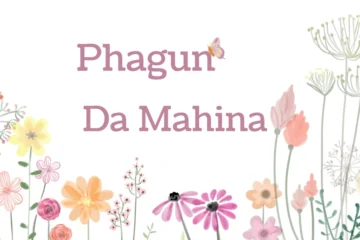In the Punjabi calendar, the months are typically referred to by their traditional names, which are based on the lunar calendar. Punjabi desi months are used in Punjab and in Punjabi communities to mark various events, festivals, and agricultural activities throughout the year and normally these are know as Punjabi Desi Months. Here are the Punjabi names of the months:
1. ਚੇਤ(Chet) 2. ਵਿਸਾਖ(Vaisakh) 3. ਜੇਠ(Jeth) 4. ਹਾੜ(Harh) 5. ਸਾਵਣ(Sawan) 6. ਭਾਦੋਂ(Bhado)
7. ਅੱਸੂ(Assu) 8. ਕੱਤਕ(Katak) 9. ਮੱਘਰ(Maghar) 10. ਪੋਹ(Poh) 11. ਮਾਘ(Magh)
12. ਫੱਗਣ(Phagun)
Understanding the Punjabi Desi Months:
The Punjabi calendar begins with the month of Chet, marking the onset of spring, and concludes with Phagun, signalling the end of winter. Each month follows the lunar cycle, resulting in variations in length and timing from year to year. The desi months not only measure time but also serve as a cultural compass, guiding agricultural activities, religious festivals, and social gatherings.
Significance of Punjabi Desi Months:
Agricultural Importance: Punjabi farmers rely heavily on the desi months for planning sowing, harvesting, and other agricultural activities. For example, Vaisakh is crucial for the wheat harvest, while Sawan (Saun) brings relief with the onset of monsoon rains.
Cultural Festivities: Every desi month is marked by vibrant cultural celebrations and religious festivals. From the joyous harvest festival of Vaisakhi in Vaisakh to the exuberant festival of colours, Holi, in Phagun, each month brings its own set of festivities.
Religious Observances: Many Punjabi festivals and religious rituals are tied to specific desi months. For instance, Diwali, the festival of lights, falls in the month of Assu, while the Sikh festival of Guru Nanak Dev Ji Jayanti is celebrated in Katak.
Here are the details about the Punjabi desi months:
1. Chet (ਚੇਤ): This month usually falls in March-April and marks the beginning of the Punjabi calendar year. It is a time of blooming flowers and the onset of spring.
2. Vaisakh (ਵਿਸਾਖ): Vaisakh typically occurs in April-May and is considered one of the most important months in the Punjabi calendar. It marks the beginning of the harvest season and is associated with the festival of Vaisakhi, a celebration of the Sikh New Year and the founding of the Khalsa Panth.
3. Jeth (ਜੇਠ): Jeth falls in May-June and is characterized by hot weather. It is a crucial time for agriculture as crops continue to grow.
4. Harh (ਹਾੜ): Harh spans June-July and is known for its scorching temperatures. It is the peak of summer, and farmers work hard to tend to their crops during this time.
5. Sawan (ਸਾਵਣ): Sawan falls in July-August and is associated with the monsoon season. It brings relief from the summer heat and is considered auspicious for weddings and other ceremonies.
6. Bhado (ਭਾਦੋਂ): Bhado typically occurs in August-September and marks the end of the monsoon season. It is a time of transition as farmers prepare for the upcoming autumn harvest.
7. Assu (ਅੱਸੂ): Assu falls in September-October and marks the beginning of the festive season in Punjab. It is a time of joy and celebration, with festivals like Navratri and Dussehra being observed.
8. Katak (ਕੱਤਕ): Katak spans October-November and is characterized by cooler temperatures. It is a time of preparation for the winter season, with farmers harvesting their crops and storing them for the colder months ahead.
9. Maghar (ਮੱਘਰ): Maghar typically occurs in November-December and marks the onset of winter. The days become shorter, and the weather grows colder, signalling the need for warmer clothing and shelter.
10. Poh (ਪੋਹ): Poh falls in December-January and is one of the coldest months in Punjab. It is a time of huddling around fires and enjoying hearty meals with family and friends.
11. Magh (ਮਾਘ): Magh spans January-February and is associated with the end of winter. The days begin to lengthen, and there is a sense of anticipation for the upcoming spring season.
12. Phagun (ਫੱਗਣ): Phagun typically occurs in February-March and marks the end of the Punjabi calendar year. It is a time of festivities and celebration, with the festival of Holi being observed with great enthusiasm.
Conclusion
In this blog, we described Punjabi Desi Months. The Punjabi desi months consists of the core of Punjab’s cultural heritage, serving as a timeless reminder of its agricultural roots, religious traditions, and social fabric. As each month unfolds, it brings with it a fabric of colours, celebrations, and rituals, weaving together the past, present, and future of Punjab’s rich cultural tapestry. Embracing the Punjabi desi months is not just about marking time but celebrating life itself, in all its variety and richness.
FAQ: Punjabi Desi months
1. What are Punjabi Desi months?
Punjabi Desi months refer to the traditional months used in the Punjabi calendar system, which is largely based on the lunar calendar.
2. How many Desi months are there in Punjabi culture?
There are 12 Desi months in Punjabi culture, corresponding to the lunar months.
3. What are the names of Punjabi Desi months?
The names of the Punjabi Desi months are: Chet, Vaisakh, Jeth, Harh, Sawan, Bhadon, Assu, Katik, Maghar, Poh, Magh, and Phagan.
4. How are Punjabi Desi months used today?
Punjabi Desi months are still referenced in traditional cultural practices, agricultural cycles, and some religious observances among Punjabi communities around the world.
5. Are Punjabi Desi months used in Sikhism?
Yes, Punjabi Desi months are used in Sikhism for determining dates of festivals and other important religious events.
6. Where can I find more information about Punjabi Desi months?
You can find detailed information in Punjabi cultural books, online resources about Punjabi culture and history, or by consulting with elders or scholars knowledgeable about Punjabi traditions.







